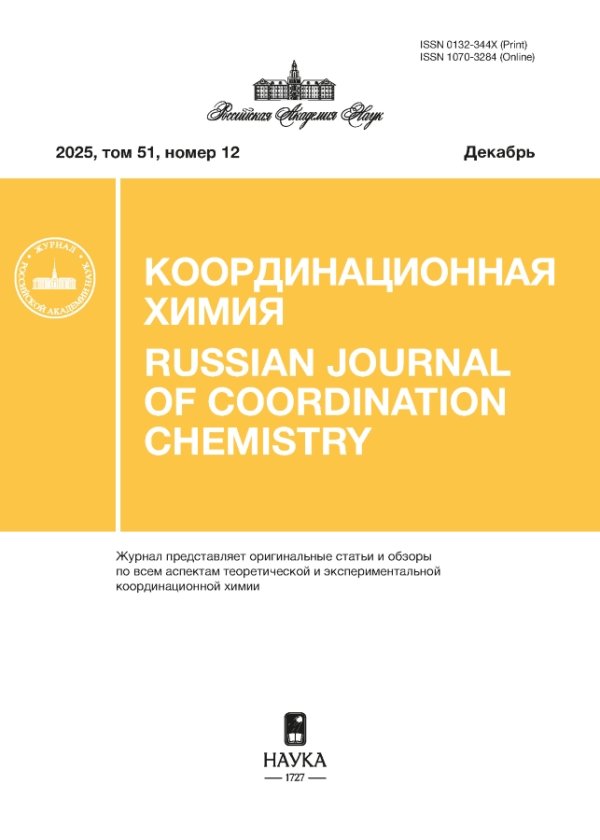Vol 50, No 5 (2024)
Articles
Synthesis and Study of Mono(arylhydrazino)acenaphthenones and Nickel Complex based on Pyridine-substituted Derivative
Abstract
Three mono(arylhydrazino)acenaphthenones, that is, mono(2-pyridylhydrazino)acenaphthenone (Py-mhan, L1), mono(4-cyanophenylhydrazino)acenaphthenone (4-CN-Ph-mhan, L2), and mono(3,4,6-trifluoro-2-pyridylhydrazino)acenaphthenone (FPy-mhan, L3), were synthesized by the reaction of acenaphthene quinone with the appropriate arylhydrazine salt; compounds L2 and L3 were obtained for the first time. The subsequent reaction of L1 with nickel chloride in 2 : 1 ratio led to the octahedral complex [Ni(Py-mhan)2] (I), in which Py-mhan acts as a tridentate ligand. All of the prepared compounds were characterized by elemental analysis, IR and 1H NMR spectroscopy, and cyclic voltammetry; the crystal structures of L3 and I were determined by X-ray diffraction.
 287-295
287-295


Photoluminescent Lanthanide(III) Complexes Based on 2-[((4-Chlorophenyl)amino)methylene]-5,5-dimethylcyclohexane-1,3-dione
Abstract
Five coordination compounds of the general formula [LnL2(NO3)3]n (Ln3+ = Eu (I), Sm (II), Tb(III), Dy (IV), and Gd (V)) are synthesized from 2-[((4-chlorophenyl)amino)methylene]-5,5-dimethylcyclohexane-1,3-dione (L). The crystal structures of the ligand and complex III are determined by X-ray diffraction (XRD) of single crystals (CIF files CCDC nos. 2298715 (L) and 2298716 (III)). Complex III is polymeric due to the bidentate-bridging coordination of the ligand by the oxygen atoms of the cyclohexanedione fragment, and the coordination number of the central atom is ten. According to the phase XRD data, all synthesized polycrystalline compounds are isostructural to the single crystals of complex III. The photoluminescence properties of the ligand and coordination compounds in the polycrystalline state are studied. The energy transfer from the ligand to lanthanide(III) ion is shown to proceed via the “antenna” mechanism in the case of the europium(III), samarium(III), and terbium(III) compounds. Among the series of the complexes, the highest quantum yield is observed for compound I (21.9%), and the sensibilization efficiency of the europium(III) complex is 43.5%.
 296-309
296-309


Coordination Compounds of Cobalt(II) Nitrate and Perchlorate with Acetamide and Carbamide: Precursors for the Synthesis of Catalytically Active Tricobalt Tetraoxide
Abstract
The reactions of cobalt(II) nitrate or perchloride with acetamide (AA) or carbamide (Ur) in an aqueous medium produce coordination compounds [Co(Ur)4](NO3)2 (I), [Co(Ur)6](NO3)2 (II), [Co(AA)4(H2O)2](NO3)2 (III), [Co(AA)4(H2O)2](NO3)2 ∙ 2AA (IV), [Co(Ur)6](ClO4)2, (V), [Co(AA)4(H2O)2](ClO4)2 (VI), and [Co(AA)6](ClO4)2 (VII). The compositions of the isolated complexes are determined by physicochemical methods, and the crystal and molecular structures of compounds II, V, VI, and VII are solved. Specific features of the thermal behavior of all synthesized compounds in a wide temperature range are studied in detail. These compounds are shown to be used as precursors in the preparation of nanosized Co3O4 using self-propagating high-temperature synthesis. The catalytic activity of thus synthesized Co3O4 in the model epoxidation of allyl alcohol is studied.
 310-321
310-321


Acyclic Diaminocarbene Platinum(IV) Complexes Synthesized by the Oxidative Addition of MeI and I2
Abstract
The oxidative addition of methyl iodide or molecular iodine to the bis(С,N-chelate) deprotonated diaminocarbene platinum(II) complexes [Pt{C(N(H)Ar)(NC(N(H)Ph)N(Ph)}2] (Ar = C6H3-2,6-Me2 (Xyl), C6H2-2,4,6-Me3 (Mes), and C6H4-4-Me (pTol)) affords the corresponding platinum(IV) derivatives in a yield of 89–99%. The addition of CF3CO2H is accompanied by the protonation of the nitrogen atoms of the diaminocarbene fragment to form the cationic complexes [[PtI(X)-{C(N(H)Ar)(NC(N(H)Ph)N(Ph)}2]CF3CO2H (X = Me, I). The structures of the compounds are determined by elemental analysis; high resolution mass spectrometry with electrospray ionization (ESI HRMS); IR spectroscopy; 1H, 13C{1H}, 19F{1H}, and 195Pt{1H} NMR spectroscopy; 2D NMR spectroscopy (1H,1Н COSY, 1H,1Н NOESY, 1H,13C HSQC, 1H,13C HMBC, 1H,15N HSQC, 1H,15N HMBC), and X-ray diffraction
(XRD) and thermogravimetric analyses. The synthesized platinum(IV) complexes are thermally stable to 200–260°C and are electroneutral molecules with the octahedral coordination sphere formed by two deprotonated diaminocarbene C,N-chelate substituents and iodine and methyl or two iodine atoms localized in the apical positions.
 322-333
322-333


Lanthanide Complexes with 1,4,7-Trimethyl-1,4,7-triazacyclononane
Abstract
The reaction of 1,4,7-trimethyl-1,4,7-triazacyclononane with samarium, gadolinium, and terbium chloride tetrahydrofuranates gives mononuclear complexes [LnCl3(Me3tacn)(THF)n] (Me3tacn = 1,4,7-trimethyl-1,4,7-triazacyclononane; Ln = Sm (I), Gd (II), n = 1; Ln = Tb (III), n = 0). The treatment of complexes I or II with 1,2,4-triphenylcyclopentadienyl potassium affords mono(cyclopentadienyl) complexes [CpPh3LnCl2(Me3tacn)] (CpPh3 = = 1,2,4-triphenylcyclopentadienyl; Ln = Sm (IV), Gd (V)). Complexes IV and V are formed even when a twofold excess of CpPh3K is used. The molecular structure of complexes I–V was established by X-ray diffraction analysis (CCDC nos. 2299485 (I), 2299487 (II), 2299486 (III), 2305352 (IV), 2306051 (V)).
 334-343
334-343


Synthesis of Halogen-Substituted [12]Mercuracarborands-4. Crystal Structure of {[(9,12-I2-C2B10H8-1,2-Hg)4]Cl}Na(H2O)n
Abstract
The reactions of the dilithium derivatives of 9,12-dihalogen-ortho-carboranes 1,2-Li2-C2B10H8-9,12-X2 (X = Cl, Br, I) with mercury chloride HgCl2 afford a number of complexes of the chloride ion with the halogen derivatives of [12] mercuracarborand-4: {[(9,12-X2-C2B10H8-1,2ʹ-Hg)4]Cl}Na · nH2O. The molecular crystal structure of the complex of the
[12]mercuracarborand-4 octaiodine derivative with the chloride ion is determined by X-ray diffraction. The substituents at the periphery of the mercury-containing macrocycle are found to exert a substantial effect on the macrocycle geometry leading to the transition from the planar to butterfly conformation, whose geometry is predetermined by a set of intermolecular interactions in the crystal.
 344-352
344-352












